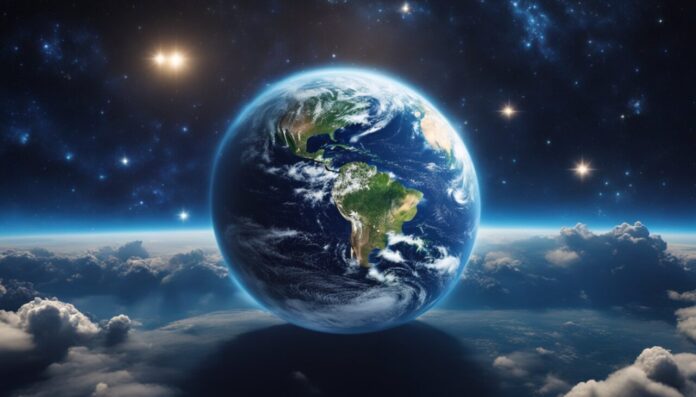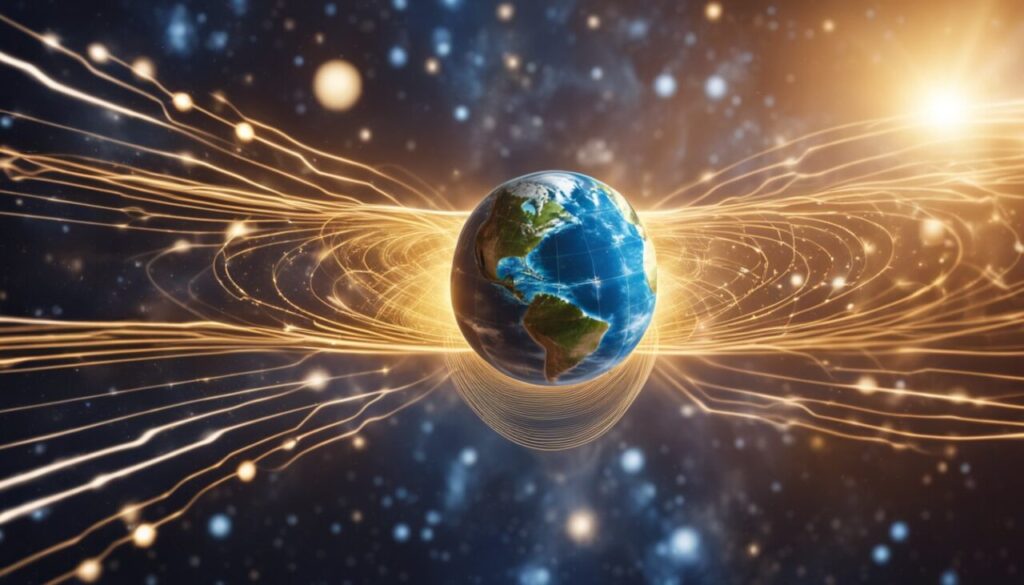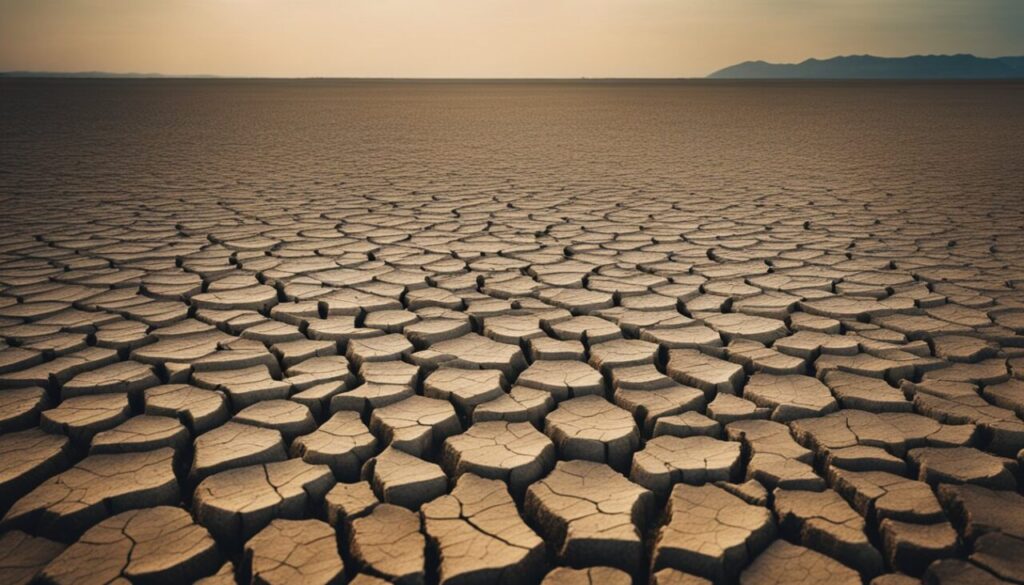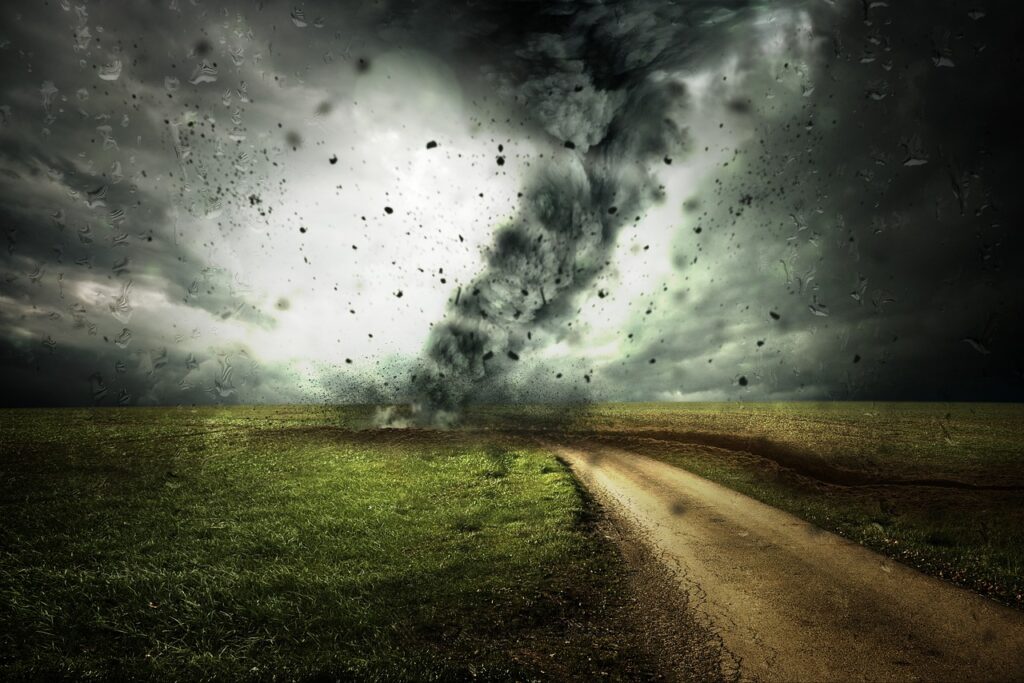
Despite the fact that the Earth rotates on its axis once every 24 hours, you cannot feel any movement. This is because you, along with everything else, including the oceans and atmosphere, are all rotating together with the Earth at a consistent speed.
So the question arises – what would happen if the Earth spun faster? Would we feel the effects of it? What would happen to society, climate, and Earth as a whole?
Let’s explore this amusing thought experiment, starting with some fundamentals.
Interesting fact: The fastest-rotating planet in our solar system is Jupiter, which rotates once every 9.9 hours.
Fundamentals of Earth’s Rotation

Why Does the Earth Rotate?
Earth rotates because it’s like a spinning top, but on a much grander scale. This spinning motion is caused by the way the Earth formed billions of years ago.
When the solar system was born, everything was swirling around, and as Earth came together, it inherited that spinning motion. This rotation gives us day and night – when one side of the Earth faces the Sun, it’s daytime, and when it faces away, it’s nighttime.
The Earth spins because of inertia, which means objects in motion tend to stay in motion unless acted upon by an outside force. The force that keeps Earth spinning smoothly is gravity, the same force that keeps us stuck to the ground.
The Earth’s rotation also creates the Coriolis effect, which influences winds and ocean currents, shaping our weather patterns and climate.
Without this rotation, life on Earth would be very different, as the cycle of day and night helps regulate temperature and provides the conditions for life to thrive.
What Is Chandler’s Wobble?

As mentioned, Earth rotates on its axis at a rate of one revolution per day, which takes approximately 24 hours to complete. However, the axis of rotation is not perfectly straight, and it wobbles slightly.
This wobble is known as Chandler’s wobble, named after American astronomer Seth Carlo Chandler. The wobble is caused by the gravitational pull of the Sun and the Moon on the Earth’s equatorial bulge.
Chandler’s wobble has a period of about 433 days and a maximum amplitude of around 9 meters.
It causes small changes in the Earth’s rotation, which can affect the length of a day by a few milliseconds.
Interesting fact: Chandler's wobble was first discovered in 1891 by American astronomer Seth Carlo Chandler. He noticed a slight, regular wobble in the Earth's rotation while analyzing astronomical observations. Chandler observed that the Earth's axis of rotation wasn't perfectly fixed, but rather moved in a small circular motion over a period of about 14 months.
Comparison of Earth’s Rotation versus Other Planets in the Solar System
Earth’s rotation is unique compared to other planets in our solar system. Some planets rotate very slowly, like Venus, which takes about 243 Earth days to complete one rotation. Others, like Jupiter, rotate very quickly, with a rotation period of just under 10 hours.
So, obviously, there are significant differences in the rotation periods of each planet in our solar system.
See the table below for complete details. Astonishing, isn’t it?
| Planet | Rotation Duration (Hours) | Rotational Speed (km/h) / (mph) |
| Mercury | 1,408 hours | 10.89 km/h (~6.77 mph) |
| Venus | 5,832 hours | 6.52 km/h (~4.05 mph) |
| Earth | 24 hours | 1,670 km/h (1,040 mph) |
| Mars | 24.6 hours | 868.22 km/h (~539.52 mph) |
| Jupiter | 9.9 hours | 45,030 km/h (~27,964.28 mph) |
| Saturn | 10.7 hours | 35,500 km/h (~22,069.06 mph) |
| Uranus | 17.2 hours | 9,906 km/h (~6,152.56 mph) |
| Neptune | 16.1 hours | 9,719 km/h (~6,040.21 mph) |
| Pluto | 153.3 hours | 96.3 km/h (~59.85 mph) |
Interesting fact: Venus rotates in the opposite direction to most planets in our solar system, a phenomenon known as retrograde rotation. This means that on Venus the Sun rises in the west and sets in the east.
Okay, so now with all of this data let’s deep dive into the consequences of Earth’s faster rotation.
Earth’s Faster Rotation and Gravitational Effects

Changes in Tidal Forces
If the Earth rotated faster, there would be significant changes in tidal forces. The gravitational pull of the Moon and Sun on the Earth’s oceans would be affected, causing the tides to become more extreme.
High tides would be higher, and low tides would be lower. This could cause flooding in coastal areas and disrupt marine ecosystems.
Impact on the Moon’s Orbit
A faster rotation of the Earth would also have an impact on the Moon’s orbit. The duration it takes for the Moon to complete one rotation on its axis matches the time it takes for the Moon to complete one orbit around Earth.
Consequently, this results in one side of the Moon consistently facing our planet.
If the Earth were to rotate faster, the Moon’s orbit would become unstable, and it could eventually drift away from the Earth.
Interesting fact: The Moon is moving away from the Earth at a rate of about 3.8 centimeters per year.
Impact on the Weight of Humans and Everything Else
Faster rotation of the Earth would also affect the weight of objects on the surface. The centrifugal force caused by the faster rotation would counteract some of the Earth’s gravity, causing objects to weigh slightly less.
However, this effect would be very small and would not be noticeable to most people.
Interesting fact: The weight of an object on the surface of the Earth varies depending on its location and altitude. For example, an object weighs slightly less at the equator than at the poles due to the Earth's rotation.
Geophysical Alterations

Centrifugal Force and Equatorial Bulge
If the Earth were to rotate faster, the centrifugal force would increase, leading to an equatorial bulge. This bulge would cause the planet to become slightly wider at the equator than at the poles.
The increase in centrifugal force would also cause the planet’s shape to change from an oblate spheroid to a more flattened shape.
Shifts in the Earth’s Crust

A faster rotation would also cause shifts in the Earth’s crust. The increase in centrifugal force would cause the solid surface of the Earth to move away from the axis of rotation, leading to changes in the planet’s geography.
The movement of the crust could cause earthquakes, volcanic eruptions, and other geologic events.
Climatic Consequences

Alterations in Weather Patterns
If Earth were to rotate faster, it would cause significant alterations in weather patterns. The increased rotational speed would result in stronger winds and more intense storms.
The Coriolis effect, which causes the rotation of air masses, would also become more pronounced, leading to changes in the direction of prevailing winds.
These changes in wind patterns would have a profound impact on the distribution of rainfall across the planet. Some areas would receive more precipitation, while others would experience prolonged droughts.
This shift in weather patterns would have huge consequences for agriculture, water resources, and the global economy.
Interesting fact: The Coriolis effect was first described by French mathematician Gaspard-Gustave de Coriolis in 1835.
Impact on Global Climate

A faster rotation of Earth would also have a rather big impact on the planet’s climate. The increased speed would cause the equator to bulge outwards, resulting in a more oblate shape for the planet. This would alter the distribution of heat across the planet, resulting in changes to global climate patterns.
The faster rotation would also cause changes in ocean currents, which play a crucial role in regulating global temperatures.
This could lead to the cooling of some regions and warming of others, with potentially catastrophic consequences for marine ecosystems.
Interesting fact: The Earth's rotation is currently slowing down at a rate of approximately 1.8 milliseconds per century.
Biological Consequences

Effect on Flora and Fauna
If the Earth were to rotate faster, it would have a substantial impact on the flora and fauna of the planet.
The increased speed of rotation would cause changes in the length of day and night, as well as changes in the intensity and duration of sunlight.
These changes would affect the growth and development of plants and animals, as well as their behavior and migration patterns.
Plants would be particularly affected by a faster rotation of the Earth. The increased intensity of sunlight during the day could lead to higher rates of photosynthesis, which could result in faster growth and larger yields.
However, the shorter nights could also have negative effects, as plants rely on darkness to produce certain hormones that regulate growth and development. This could lead to stunted growth or other developmental problems.
Animals would also be affected by a faster rotation of the Earth. Changes in the length of day and night could disrupt their internal clocks and circadian rhythms, which could affect their behavior and migration patterns.
For example, birds that rely on sunlight to navigate during migration could become disoriented and lost if the duration or intensity of sunlight changes.
Human Health and Circadian Rhythms

The faster rotation of the Earth could also have significant implications for human health and circadian rhythms. The human body relies on a 24-hour circadian rhythm to regulate sleep, hormone production, and other physiological processes.
Changes in the length of day and night could disrupt this rhythm, leading to sleep disorders, mood disturbances, and other health problems.
And as mentioned, faster rotation of the Earth could lead to more frequent and severe weather events, such as storms and hurricanes, which could then have very negative effects on human health, as well as on the availability of food and water.
Interesting fact: The human circadian rhythm is not only regulated by light but also by other environmental cues, such as temperature and social interactions. A faster rotation of the Earth could disrupt these cues and lead to further disruptions in the circadian rhythm.
Theoretical Considerations

At the end let’s play slightly with theoretical physics and hypothetical faster rotation of the Earth.
For example:
- Relativity: According to Einstein’s theory of general relativity, spacetime is curved by mass and energy. Changes in the Earth’s rotation speed could alter the distribution of mass-energy, leading to slight modifications in the curvature of spacetime around the planet. This could affect the local measurements of time, space, and gravity.
- Angular Momentum Conservation: The Earth’s rotation is governed by the principle of angular momentum conservation. Increasing the rotational speed would require a transfer of angular momentum from other systems, such as the Earth-Moon system or the Earth’s own interior. Understanding how this transfer occurs and its implications would be a key aspect of theoretical physics.
- Quantum Mechanics: Quantum effects might come into play when considering the behavior of particles and fields on a rapidly rotating Earth. Quantum mechanics describes the behavior of matter and energy at the smallest scales, and studying how quantum phenomena manifest under conditions of high rotation rates could yield different insights into fundamental physics.
- Thermodynamics: The faster rotation of the Earth would affect the distribution of thermal energy across the planet’s surface. This would have implications for thermodynamic processes such as heat transfer, entropy production, and the efficiency of energy conversion systems. Understanding the thermodynamics of a rapidly rotating Earth would be essential for predicting and mitigating potential environmental impacts.
- Topological Effects: High rotation rates can induce topological effects in physical systems. In the context of the Earth’s rotation, this could manifest as changes in the topology of spacetime or the emergence of topological defects in certain materials or fields. Exploring these topological aspects from a theoretical physics perspective could lead to new insights into the nature of rotation and its effects on the Earth’s dynamics.
- String Theory and Extra Dimensions: Some theories in physics, such as string theory, suggest the existence of extra spatial dimensions beyond the familiar three dimensions of space. Changes in the Earth’s rotation speed could potentially influence the dynamics of these extra dimensions, offering testable predictions for theories involving higher-dimensional spaces.
- Unified Field Theories: The quest for a unified theory of fundamental forces, such as the grand unified theory or a theory of everything, involves understanding the interplay between gravity, electromagnetism, and nuclear forces. Changes in the Earth’s rotation speed could provide experimental constraints on such unified theories by testing their predictions in a novel regime of rotational dynamics.
- Chaos Theory: Rapid changes in rotational speed could introduce chaotic behavior into the Earth’s dynamics, characterized by sensitivity to initial conditions and unpredictable outcomes. Exploring the chaotic aspects of a fast-rotating Earth would require sophisticated mathematical and computational models, drawing upon concepts from chaos theory and nonlinear dynamics.
- Cosmic Microwave Background Radiation: Changes in the Earth’s rotation could potentially affect observations of the cosmic microwave background (CMB) radiation, which provides crucial insights into the early universe. Understanding how the Earth’s rotation influences CMB measurements would be important for cosmological studies and precision cosmology.
- Astrophysical Signatures: A faster rotation of the Earth could lead to detectable astrophysical signatures, such as changes in the distribution of cosmic rays or the modulation of astronomical signals. Exploring these signatures would require interdisciplinary approaches involving theoretical physics, astrophysics, and observational astronomy.
Conclusion

In conclusion, if the Earth were to rotate faster, it would literally have an impact on everything on our planet. The increase in speed would cause changes in the length of the day, weather patterns, and the overall climate.
The effects of a faster rotation would be felt most significantly at the equator, where the increased centrifugal force would cause the planet to bulge outwards and create a noticeable change in the shape of the Earth.
Ultimately the consequences would be overall very negative. The increased wind speeds and changes in weather patterns would lead to more frequent and severe natural disasters, such as hurricanes and tornadoes.
Additionally, the shift in climate would cause disruptions in ecosystems and food chains, leading to a decline in biodiversity.
Finally, at the end of the day (pun intended) the Earth’s rotation is in reality slowing down, but at a very gradual pace. It is estimated that in about 140 million years, a day on Earth will be 25 hours long instead of the current 24 hours.
So, we don’t have to worry about Earth spinning faster but instead spinning slower.



























